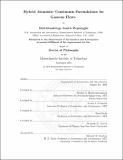Hybrid atomistic-continuum formulations for gaseous flows
Author(s)
Wijesinghe, Hettithanthrige Sanith, 1974-
DownloadFull printable version (5.004Mb)
Other Contributors
Massachusetts Institute of Technology. Dept. of Aeronautics and Astronautics.
Advisor
Nicholas G. Hadjiconstantinou.
Terms of use
Metadata
Show full item recordAbstract
Hybrid atomistic-continuum formulations allow the simulation of complex hydrodynamic phenomena at the nano and micro scales without the prohibitive cost of a fully atomistic approach. This is achieved through a domain decomposition strategy whereby the atomistic model is limited to regions of the flow field where required and the continuum model is implemented side-by-side in the remainder of the domain within a single computational framework. The current work is focused on arguably the most critical elements of any hybrid formulation: the atomistic-continuum coupling method and the imposition of continuum boundary conditions on the atomistic subdomain. The relative merits of different approaches for both are delineated and demonstrated using sample test problems. For the case of incompressible steady gaseous flows a hybrid formulation is developed using a finite element method for the continuum subdomain and the direct simulation Monte Carlo (DSMC) method for the atomistic subdomain. The Schwarz alternating method is used to couple both subdomains using an overlap region across which the successive exchange of Dirichlet boundary conditions yields a steady state solution. This approach has the advantages of decoupling both length scales and time scales of the atomistic and continuum solvers leading to superior performance over conventional explicit schemes. Continuum boundary conditions are imposed on the atomistic subdomain using the Chapman-Enskog distribution function in conjunction with particle reservoirs. A driven cavity test problem shows convergence in 0(10) Schwarz iterations for flow Reynolds numbers 0(1). (cont.) The Schwarz method is also, for the first time, extended to couple unsteady hybrid incompressible flows. Tests for an impulsively driven Couette flow highlight the versatility of this approach to advance solutions to arbitrary times through appropriate interpolation of Dirichlet boundary conditions. Techniques are also developed using limited ensemble averaging of the atomistic solution to realize significant computational savings over a standard ensemble averaging process while maintaining the same variance reduction. Finally an unsteady compressible hybrid formulation utilizing Adaptive Mesh and Algorithm Refinement (AMAR) technology is described. DSMC is used to model the atomistic regions on the finest grid of the adaptive hierarchy. The continuum flow is solved using a second order Godunov scheme. New gradient-based tolerance parameters are developed to provide robust detection and tracking of concentration diffusion fronts and stationary and moving shock waves. Extension of AMAR to binary gas mixtures is also completed and demonstrated using a binary gas shock wave test problem.
Description
Thesis (Ph. D.)--Massachusetts Institute of Technology, Dept. of Aeronautics and Astronautics, 2003. Includes bibliographical references (p. 147-156). This electronic version was submitted by the student author. The certified thesis is available in the Institute Archives and Special Collections.
Date issued
2003Department
Massachusetts Institute of Technology. Department of Aeronautics and AstronauticsPublisher
Massachusetts Institute of Technology
Keywords
Aeronautics and Astronautics.